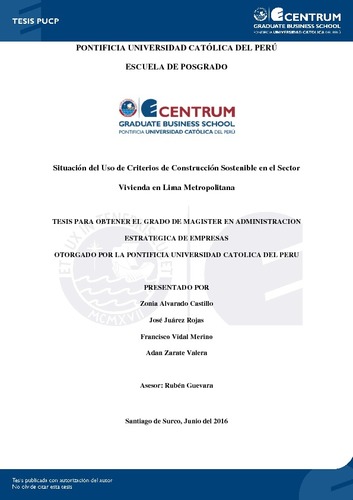| dc.contributor.advisor | Guevara Moncada, Rubén | |
| dc.contributor.author | Alvarado Castillo, Zonia | es_ES |
| dc.contributor.author | Juárez Rojas, José | es_ES |
| dc.contributor.author | Vidal Merino, Francisco | es_ES |
| dc.contributor.author | Zarate Valera, Adan | es_ES |
| dc.date.accessioned | 2016-11-07T16:45:58Z | |
| dc.date.available | 2016-11-07T16:45:58Z | |
| dc.date.created | 2016 | |
| dc.date.issued | 2016-11-07 | |
| dc.identifier.uri | http://hdl.handle.net/20.500.12404/7428 | |
| dc.description.abstract | La presente investigación tuvo por objetivo identificar la situación actual del uso de criterios de construcción sostenible y su valoración, para el desarrollo de proyectos de vivienda en Lima Metropolitana. El instrumento usado para este fin fue un cuestionario basado en el sistema Leadership in Energy & Environmental Design (LEED) v4, desarrollado por el U.S. Green Building Council (USGBC). La población estuvo compuesta por 14
empresas inmobiliarias dedicadas al desarrollo y construcción de proyectos de viviendas en Lima Metropolitana, adscritas a la Asociación de Desarrolladores Inmobiliarios (ADI). Los resultados de la investigación mostraron que las empresas entrevistadas consideran, para el desarrollo de sus proyectos, el uso de prácticas de construcción sostenible, cuya implementación obedece principalmente a factores de tipo comercial. Asimismo, todas las empresas entrevistadas valoraron como importante la inclusión de criterios de construcción sostenible para el desarrollo de proyectos de vivienda, aunque indicaron que hacen falta incentivos para impulsar su desarrollo. De acuerdo a los resultados, el uso de criterios de construcción sostenible se concentra en aplicar estrategias de sostenibilidad vinculadas a: (a) uso eficiente de agua, (b) uso eficiente de energía, y (c) sitios sustentables. Entre las principales barreras que frenan la construcción sostenible tenemos: (a) sobrecostos de inversión; (b) falta de programas de construcción sostenible que promuevan incentivos
fiscales, tributarios y financiamiento para atraer nuevas inversiones; y (c) desconocimiento sobre los beneficios de la construcción sostenible. Por otro lado, las empresas entrevistadas mencionaron que sus clientes no valoran la incorporación de prácticas de construcción sostenible en sus proyectos, menos aún en el caso de viviendas sociales, donde la demanda es muy sensible al incremento de los costos. Por lo tanto, la aplicación de soluciones de construcción sostenible depende no solo del Estado, sino también de las empresas y clientes quienes deben actuar en forma responsable con el medio ambiente y la sociedad | es_ES |
| dc.description.abstract | This research aimed to identify the current use of sustainable construction criteria and their assessment, for the development of real estate housing projects in Lima Metropolitana. The instrument used for this purpose was a questionnaire based on the Leadership in Energy & Environmental Design (LEED) v4 system, developed by the U.S. Green Building Council (USGBC). The population consisted of 14 real estate companies who develop and construct
housing projects in Lima Metropolitana, and are part of the Asociación de Desarrolladores Inmobiliarios (ADI). The research results showed that the surveyed companies consider, for their project developments, the use of sustainable building practices, whose implementation is mainly due to commercial factors. In addition, all surveyed companies assessed as important the inclusion of sustainable construction criteria for the development of housing projects, although they indicated that they lack incentives to encourage its development. According results, the use of sustainable construction criteria focuses on implementing sustainability strategies related to: (a) efficient use of water, (b) efficient use of energy, and (c) sustainable sites. Among the main barriers that prevent sustainable construction in our country, we have: (a) the investment cost overruns; (b) lack of sustainable construction programs that promote fiscal, tax and funding incentives to attract new investments; and (c) lack of knowledge about the benefits of sustainable construction. On the other hand, the companies interviewed mentioned that their customers do not value incorporating sustainable building practices in their projects, even less in the case of social housing, where the demand is very sensitive to cost increments. Therefore, the application of sustainable construction solutions not only depends on the government actions, but also of companies and customers who should act responsibly towards the environment and society. | es_ES |
| dc.language.iso | spa | es_ES |
| dc.publisher | Pontificia Universidad Católica del Perú | es_ES |
| dc.rights | Atribución-NoComercial-SinDerivadas 2.5 Perú | * |
| dc.rights | info:eu-repo/semantics/openAccess | es_ES |
| dc.rights.uri | http://creativecommons.org/licenses/by-nc-nd/2.5/pe/ | * |
| dc.subject | Construcción sostenible | es_ES |
| dc.subject | Materiales de construcción | es_ES |
| dc.subject | Investigación cuantitativa | es_ES |
| dc.title | Situación del uso de criterios de construcción sostenible en el sector vivienda en Lima Metropolitana | es_ES |
| dc.type | info:eu-repo/semantics/masterThesis | es_ES |
| thesis.degree.name | Magíster en Administración Estratégica de Empresas | es_ES |
| thesis.degree.level | Maestría | es_ES |
| thesis.degree.grantor | Pontificia Universidad Católica del Perú. CENTRUM | es_ES |
| thesis.degree.discipline | Administración Estratégica de Empresas | es_ES |
| renati.advisor.orcid | https://orcid.org/0000-0002-4795-2557 | es_ES |
| renati.discipline | 413307 | es_ES |
| renati.level | https://purl.org/pe-repo/renati/level#maestro | es_ES |
| renati.type | https://purl.org/pe-repo/renati/type#tesis | es_ES |
| dc.publisher.country | PE | es_ES |
| dc.subject.ocde | https://purl.org/pe-repo/ocde/ford#5.02.04 | es_ES |






